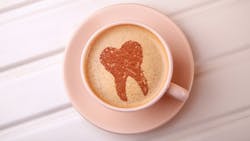A recent request from an RDH reader asked about research acknowledging the benefits of stain removal. We quickly sent the question to several opinion leaders and educational faculty and learned there were few to no documented studies.
We all have a nemesis of one type or another—an opponent that cannot be beaten or overcome. Dental hygienists share the same challenging nemesis: stain. Just the word sends us into a tailspin. We see the notorious patient’s name on our schedule and begin listing the armamentarium we will need for the appointment. We know we’ll mostly likely run over the time limit, and the patient could possibly also have a periodontal condition.
In addition to the patients we already know will require more time, what about those who have not had a dental visit for some time due to COVID or other reasons and have been ingesting staining food and beverage for several years?
What is it with stain?
Is it our drive to send patients out all shiny and bright? To make the surface feel smooth? A nice esthetic appearance? Their request? Our standards of care?
Just as the Great Barrier Reef forms by attaching to its own roughness, stain collects on rough surfaces. So if we leave stain, doesn’t the surface attract more biofilm, adding more bacterial nutrients?
In “It’s all about that biofilm,” Anne O. Rice notes that “the biofilm forms a physical barrier… If it is not removed regularly, the biofilm undergoes maturation and the resulting pathogenic bacteria complex leads to caries, gingivitis, and periodontitis.”
There’s only so much room to attach, so naturally it will grow and form under the gingiva, starting the inflammation process that would lead to gingivitis and periodontitis. Or it will detach from its current home and set up a new community in another part of the oral cavity.
One person suggested that using tooth whitening will remove the stain. Maybe, but that’s not a healthy solution—it would still leave the roughness gripping on to the pellicle of teeth. The top surface of the stain may “whiten up,” but there are still sub surface bacterial layers to deal with.
Another way to think of stain is that it’s like moss (and if you happen to live in the Pacific Northwest, you know all about moss). It’s embedded in decks, in lawns, and on roofs, attached to trees, and in chair cushions. Moss doesn’t go away until some type of ferrous sulfate is sprinkled on the roofs, hand removed from lawns, then aerated and dethatched or sprinkled with specific products for moss removal. Chairs and cushions are scrubbed with bleach or vinegar, decks are stripped and restained.
But even using a power sprayer—as we do with a cavitron in the mouth—it eventually comes back.
Where do you stand on this topic? Do you have documented resources you use or could share? We at RDH would love to hear from you and compile your messages to share with your dental hygiene colleagues. Together we can find ways to resolve our top clinical nemesis. Please email [email protected].
